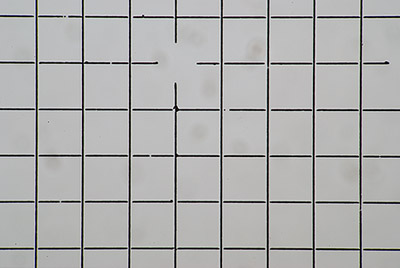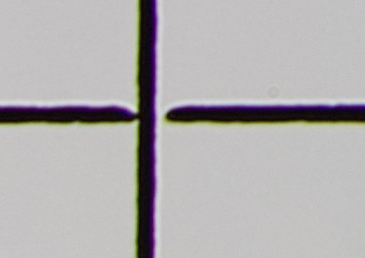Notes on practical
aspects of using the Nikon D80 DSLR for photomicrography
A
hobbyist's personal perspective by David Walker, UK
|
|
Salient
points from tests below on author's Zeiss microscope:
-
The Nikon 10 Mpixel D80 seems a competent camera
for photomicroscopy if sought as an extra feature to traditional
photo work; its
lack of lens-off metering and true mirror lock can be
worked around, as users have found for the D50.
-
The D80's 'exposure delay' mode (shutter release 0.4 sec after
mirror up) with a 40x objective does permit vibration free work at 1/250th or at longer than 1/8th sec
with tungsten lighting (on author's setup) .
-
For 10x objective and lower mags, no evidence of camera vibration
seen when using 'exposure delay' with tungsten lighting at normal
shutter speeds e.g. 1/250th.
- The D80 is not currently supported by the Nikon
Capture / RAW software compatible with the D50/D70/D200
and there's a considerable
extra cost for Nikon's new 'Control Pro' software with separate
RAW editor 'Capture NX' (ca. $220 for both).
-
Buying just the 'Camera Contro Pro' software (ca. $70) keeps cost down
if Photoshop Elements 3+ is owned.
- On a Zeiss
scope the standard 10x Kpl W eyepiece was a competent projection
lens for Zeiss achro and apo objectives with no evidence of undue aberrations in crop area.
-
Little if any improvement was spotted in
test images taken with the 10 Mpixel D80 cf 6 Mpixel D50; image
appraisal e.g. critical focus seems harder with such large
images.
|
The
Nikon D80 is a 10.2 effective Mpixel DSLR released in 2006 and has received
good reviews; it has a typical price of £539 / $925 for
the D80 body in UK / US (Jan 2007).
This
article assesses from my hobbyist's perspective selected features of the
D80 (on loan to me) for photomicroscopy on a Zeiss stand. In particular I was interested
to see how it compared to the 6.1 Mpixel Nikon D50 which the author is very familiar
with. Fellow microscopy enthusiasts trying other makes and models of
DSLRs have also shared their experiences.
(See links.)
The
two key features not on the D80 cf the D200 of potential interest to the microscopist
are a true mirror lock and retaining metering with the lens off. The D80
does have an 'exposure delay mode' where the shutter is triggered 0.4s after
the mirror goes up. The Nikon manual notes an example of the potential
use of this feature is 'microscope photography'.
Mirror
lock on a DSLR (as on SLRs) does not necessarily remove all camera sourced vibrations
for photomicroscopy, the shutter can also contribute (e.g. see
Ian Walker's experiences with the Canon 350D on a sturdy Zeiss stand). In-camera
metering is useful but not vital because the DSLR allows fast assessment
of an exposure on the camera's LCD or on a PC screen within a few seconds of capture if software for remote camera control / image transfer software is
used.
Microscope
- camera set-up
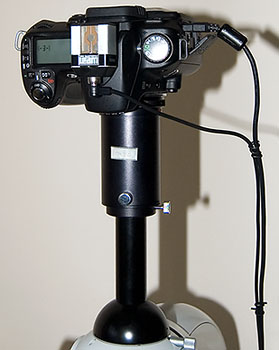 The
D80 was attached via a third party 35 mm photomicro' adaptor to a vertical
monocular tube on the spare top port of a Zeiss Photomicroscope III (shown right). A
USB 2.0 cable enables remote control and image transfer to a PC. A Wein SafeSync
adaptor was used for flash work with an old SunPak
2400 flash gun when required (sat on field lens below condenser).
The
D80 was attached via a third party 35 mm photomicro' adaptor to a vertical
monocular tube on the spare top port of a Zeiss Photomicroscope III (shown right). A
USB 2.0 cable enables remote control and image transfer to a PC. A Wein SafeSync
adaptor was used for flash work with an old SunPak
2400 flash gun when required (sat on field lens below condenser).
A sturdier Zeiss vertical tube is available
for 35 mm work, I'm still seeking one, but the present camera attachment may well be similar
to that of other hobbyists.
The
projection eyepiece was a Zeiss 10x Kpl W eyepiece (on small collar). In the absence of a suitable projection
eyepiece, I've previously found that this gives a good flat field essentially aberration
free for Zeiss objectives in the crop area of the sensor with a D50
DSLR. Visual / camera focus was matched by using the dioptre setting
of the bino head.
This
set-up captured 66% of the field that a 35 mm SLR captured. I tried a 4:1 projection eyepiece from Zeiss but found
it gave no benefit in field or image quality over the 10x Kpl eyepiece. Some
DLSR users (e.g. Ted Clarke and Jan Hinsch, see links) have shown that
a 35mm SLR lens of appropriate focal length can be a good match for
projection in photomicroscopy; an approach I'm keen to try but isn't practical
at present on my set-up because of a lack of a sturdy external camera support
or custom coupling.
Despite
a good parallax set-up for camera focussing, final
critical focussing for such large images was often required by inspecting a sequence
of images transferred to the PC while making tiny
focus adjustments. The image was viewable on the PC screen after ca. 3 secs for a full res RAW image.
Above:
Zeiss 10x Kpl W as a projection eyepiece - check of image quality
with 0.2 mm reticle.
Zeiss 4x NA0.16 planapo.
Left: Full frame of D80 capture. A full frame has a little pin cushion
but otherwise good linearity and sharp.
Right: Top right corner crop
of full frame; some chromatic aberration at edges but this is a tiny
crop from a poster sized 'screen' print (see below).
Interfacing
camera with a PC for remote camera control and image transfer
The
Nikon D80 is apparently not currently supported by Nikon Capture 4.x software i.e. the camera
remote control and RAW editing package that supports the D50 / 70 / 200. Nikon
have brought out two new software packages 'Camera Control Pro' for remote
control and 'Capture NX' for RAW editing. To buy both these packages is an extra £178 /
$220 typical cost in UK/US. (Nikon Capture 4.x wasn't a trivial
purchase at £80/$90). There's 30 day free trials of the two packages
downloadable from the Nikon website and they offer an upgrade path for Nikon Capture owners.
Only the Camera Control Pro software
alone is required if
a potential D80 buyer has photoediting software that supports Nikon's RAW files,
e.g Photoshop Elements 3+ or CS with Adobe's Camera Raw 3.6 plug-in. Saving captured
image files to jpeg avoids the need for RAW support but loses the advantages that RAW offers.
For
this review I used the trial Nikon Control Pro software and Photoshop Elements
3 as my PC is next to the microscope. This proximity isn't always practical
and images saved to card can be edited later, although for me the almost instant
image review and ability to tweak fine focus in particular was an invaluable
feature.
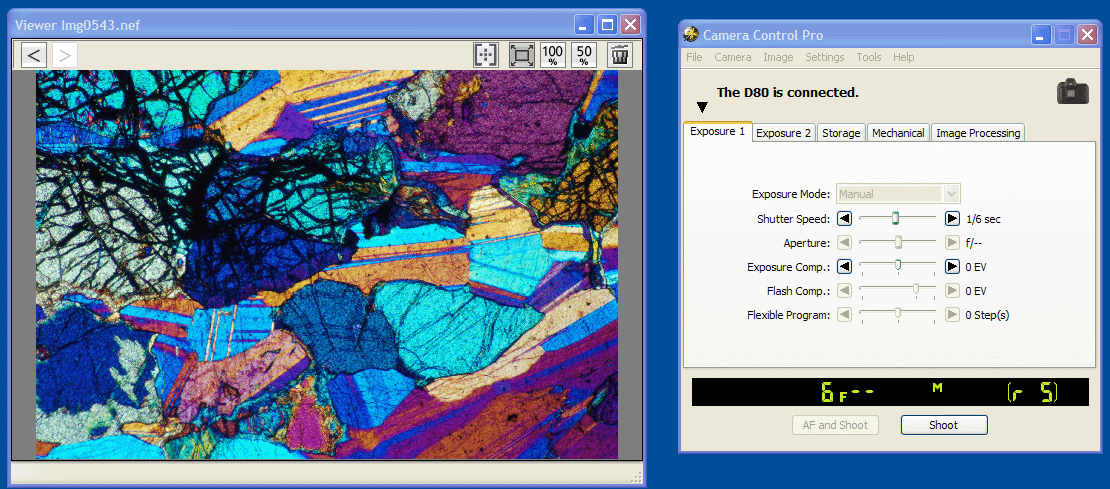
The
new Nikon 'Camera Control Pro' interface (above right) is essentially the
same as Capture 4. The D80's 'exposure delay' mode can be set in a sub-menu.
The simple viewer (above left) I liked using, with its options for viewing size and
delete, although it offers no histogram for post-capture exposure checks.
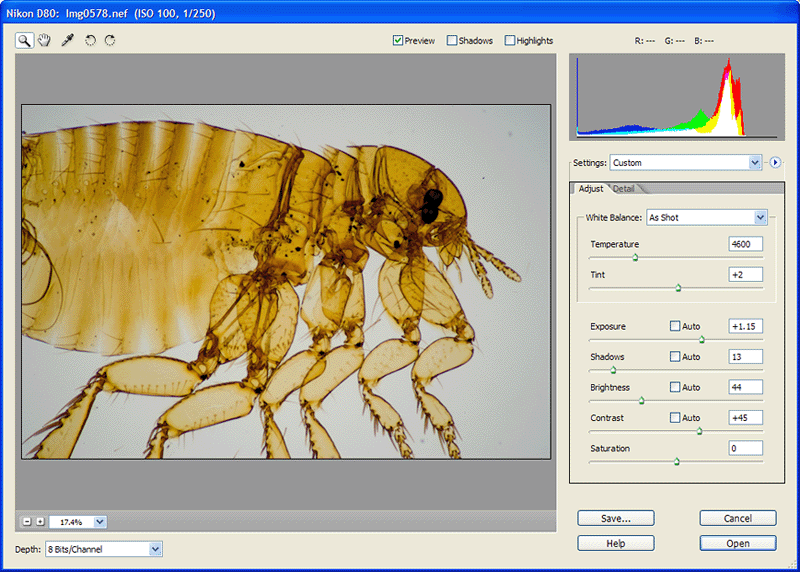
Above:
The Adobe RAW 3.6 update for Photoshop Elements 3+ / CS supports the D80's
NEF (RAW) file format and offers the basic RAW image adjustment features.
Histograms, which are useful for critical highlight / shadow detail
exposure check, would have to be viewed after opening a file in Photoshop.
The additional features which Nikon Capture 4 has aren't offered. (See footnote
on setting up.)
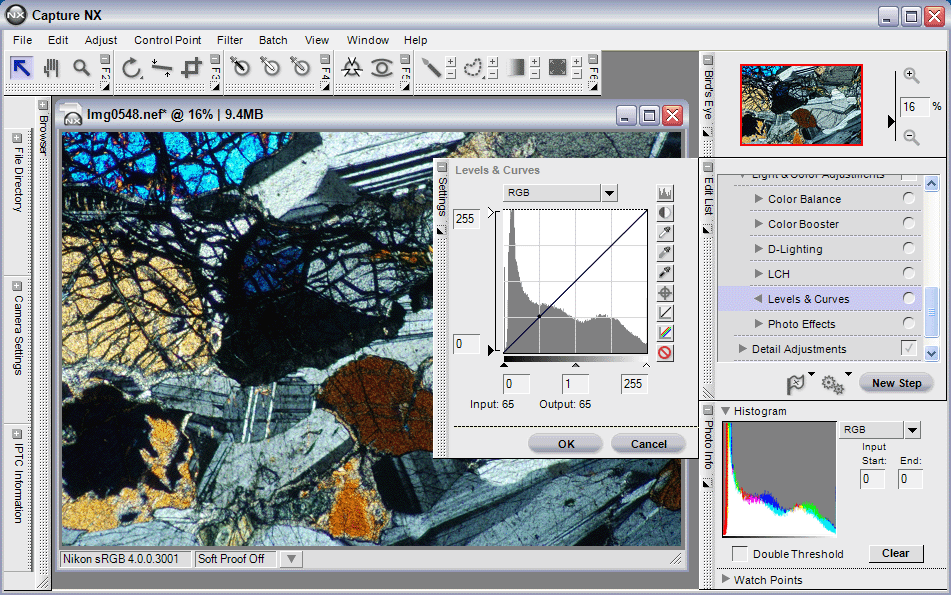
Above:
Nikon 'Capture NX' the expensive RAW editing package available separately
to edit Nikon RAW files (and other formats like jpeg) looks a very sophisticated package
from
a trial download and may require as much commitment
to get the most out of as say Photoshop does.
Potential
oversampling
and Image Appraisal
For
an excellent discussion of the factors affecting sampling with interactive Java tutorials to show
when oversampling may occur, see the links below to the Nikon MicroscopyU website. These tutorials clearly show
that capturing an image and retaining detail at the lowest
magnifications requires the greatest pixel count (Mpixels) but
at the highest mags a quite modest sensor can often suffice for screen
images. So for the typical hobbyist like myself using objectives from the lowest
to highest power, it's worth being aware of when oversampling occurs and
compare captured images with the visual to see whether it's detrimental.
My own preference, as I don't require large prints and often just screen images,
is to switch to a modest 1.3 Mpixel webcam or even security style camera for
image capture with a 40x objective and higher. I find the heavily resized
DSLR images less satisfactory at this power and prefer the ease of on-screen 'live
view' focus that a better matched sensor gives (see examples below) especially
for live organisms.
From
a practical standpoint, within a given budget, normal
photo requirements such as print size most likely govern the DSLR sensor size so the
specs may have been predetermined before the bonus of use for photomicroscopy.
To
appraise DSLR images after capture, there's a natural tendency to 'pixel peep' as it has been dubbed
i.e. viewing images at 100% on screen. I do it myself, but need to keep in mind that for the typical 100 dpi LCD
screen on my PC this is equivalent
to viewing a poster sized 'print' on screen of 38 x 26 inch from a close distance
so even when focussed they can look soft, especially as 'out of camera' DSLR
images tend not to have the same sharpening that the consumer digicams often
have.
Assessment
of the D80 'exposure delay mode' feature for vibration reduction
Every
photomicro set-up is of course different, so the results below can only be illustrative
for the author's set-up.
The camera
vibration with tungsten lighting was assessed using a similar
procedure to that suggested by Zeiss in their excellent 'Photomicrography with
35 mm SLR cameras' which is downloadable from their website;
i.e. shutter speeds from 1 sec to 1/250 sec captured a sequence of images using
the 10x objective and 40x objective. Focus
was judged by viewing images at 100% with a reference image
taken with electronic flash i.e. where vibration wouldn't be a factor.
The
shutter speed windows which gave vibration free results are summarised below.
|
Objective
|
Without shutter delay
|
With shutter delay
|
|
10x
|
ca. 1/8th or longer
|
all speeds
|
|
40x
|
1 sec or longer
|
1/8 sec or longer and 1/250
or shorter
|
A selection of images from these tests are compared
below. Note that these are tiny crops from the poster sized 100% frame when
viewed on screen
and illustrate that image appraisal
at 100% image view for 6+ Mpixels is often more a case of judging the point of least softness.
|
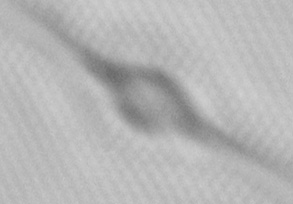
1/250th
tungsten,
no exposure delay mode.
|
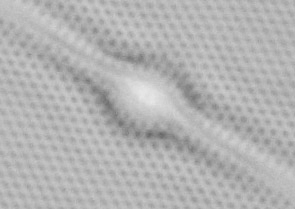
1/250th
tungsten,
exposure delay set.
|
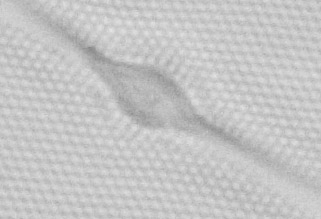
1/250th,
electronic flash.
|
Above: D80 shutter vibration
test, 40x objective: ISO 200 40x NA0.75 Zeiss Neofluar
objective, slight oblique illumination, diatom P. angulatum central
detail (Klaus Kemp 8 form test slide). Note
that the focus points aren't exactly the same, the faintest touch of fine
focus gives the black/white effect of detail for this diatom.
This D80's 'exposure delay' mode (shutter release 0.4 sec
after mirror lock) was valuable for removing vibration at 1/250th or shorter, a shutter
speed I wouldn't normally regard as usable for photomicroscopy with tungsten
lighting. The test was 'cycled' and repeated a number of times to ensure
genuine.
This 'exposure delay' was not a
benefit on the author's set-up below 1/250th until 1/8th sec or longer. Presumably
any residual shake from the shutter release, or decaying vibration from
mirror has been removed by the high shutter speed.
|
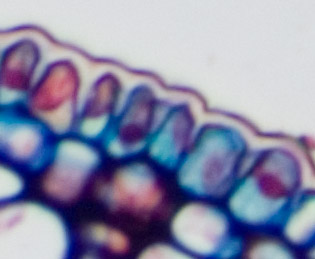
1/250th,
no exposure delay mode.
|
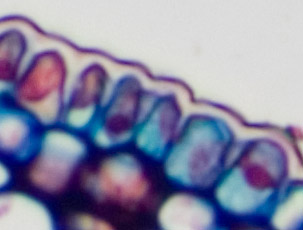
1/250th,
exposure delay set.
|
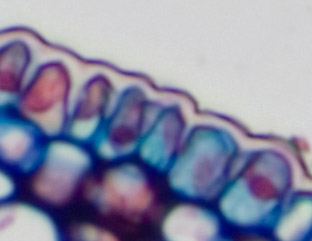
1/250th,
electronic flash.
|
Above: D80 shutter vibration
test, 10x objective: ISO 200 10x NA0.22 Zeiss planachro' objective.
Mexican orange t/s stem section, Biosil slide. There's a little
loss of crispness without 'exposure delay' (see above image sequence) so the
feature is best left
on for most tungsten work.
Many of my photomicrography interests are with
a 10x objective or lower. I used the
D80 camera with tungsten lighting at typically 1/250th with 'exposure delay'
with no fear of the camera mirror or shutter causing vibration.
At
40x objective and above, especially where the microscopy technique may
demand shutter speeds lower than 1/250th, I would prefer to use flash (as I
do on my D50) to ensure vibration free results.
Six
versus ten megapixels (D80 cf D50)
I
had a stab at comparing images near the limit of visual acuity at low mags
on the D50 cf the D80 where the extra megapixels of the D80 are most likely
to show any benefits. Two test subjects are below.
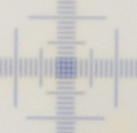
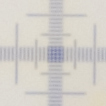
Above:
Motic slide micrometer, divisions 10 micron. Objective Zeiss 1x NA0.04
planachro. Left: D80 10 Mpixel, right: D50 6 Mpixel, both crop of 100% which occupies
a tiny portion of the frame. (Tungsten, 1/250th, flash no sharper).
I
rarely use Zeiss' quirky 1x objective and have found it tricky for
good photomicroscopy, but as the lowest mag objective, the 10 micron divisions
are approaching the objective's theoretical 7.25 micron resolution. With 10x eyepieces I could only just resolve the central 10 micron grid with my eyes
so both cameras seem capable of recording the finest detail my eye
could see.
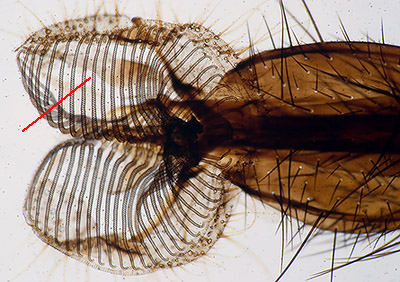
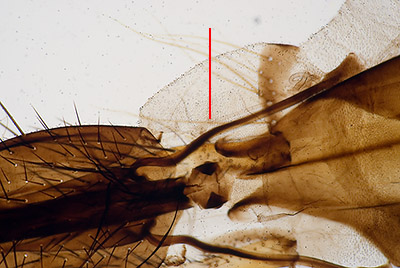
Above:
Blowfly proboscis, Zeiss 4x NA0.16 planapo, showing areas of detail where
crops below were taken.
Slide prepared by author on the late Eric Marson's
slide making course .
|
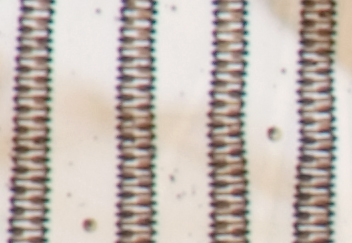
Above:
D80, crop from 100%.
|
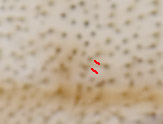
Above:
D80 crop from 100%.
|
|
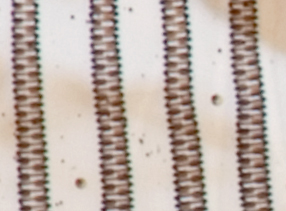
Above:
D50, crop from 100%.
|
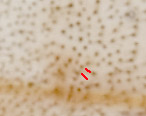
Above:
D50 crop from 100%.
|
Above:
Spitta in his superb book 'Microscopy',
2nd edition (1909), discusses the classic blowfly proboscis as a good
test for low mag objectives. There's a hint of some chromatic aberration even from a centre crop when
the images are viewed in this detail. The very fine hair bases (above right) are finer detail (also discussed
by Spitta) and the two marked in red are ca. 3.6 microns apart (well within
the Zeiss 4/0.16 objective's capabilities).
For
the subjects tried, I was struggling to see any marked differences in image
detail between the D50 and D80. Camera review sites do
show significantly extra line pair resolution for standard test charts and a
prime lens in normal photo work for the D80 cf D50 but perhaps may not be evident
in most photomicroscopy subjects.
I'd be interested to hear suggestions from readers of demanding test
subjects for the microscope at the lower mags.
Selection
of images from the D80
So,
enough of the 'pixel peeping'(!), below are a selection of images from the D80. For
resizing
the huge 10 Mpixel images for the screen, the Photoshop 'WP Pro' plug-in by Fred Miranda was used, with 'low sharpening'
set.
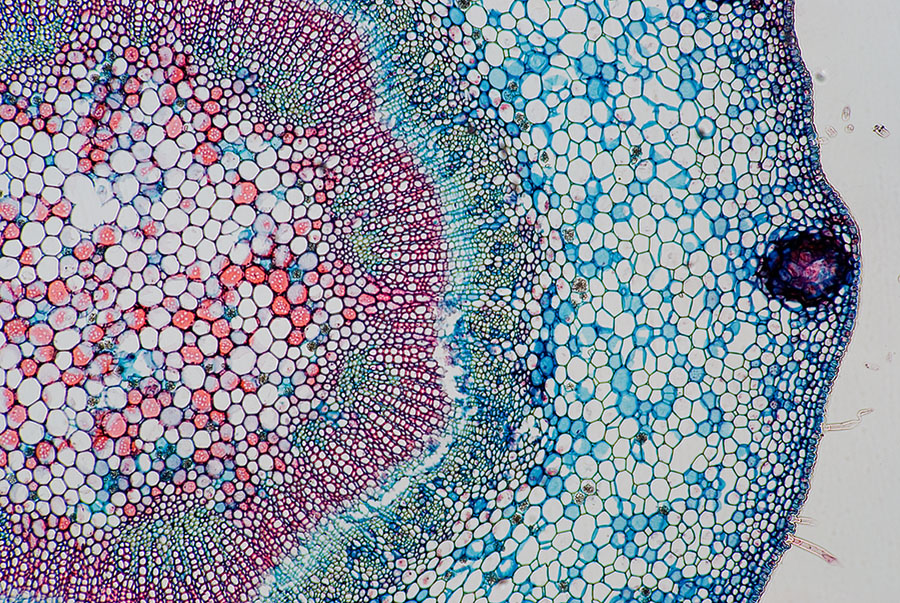
Mexican
orange, T/S stem, Biosil slide. D80 full frame image, Zeiss 4x NA0.16 planapo.
Flash. The D80 gave good contrasty results out of the camera with good tonal
range with only slight tweaks usually required. The camera white balance
was left on Auto which did a competent job, with final white balance correction
if needed in Photoshop Elements.
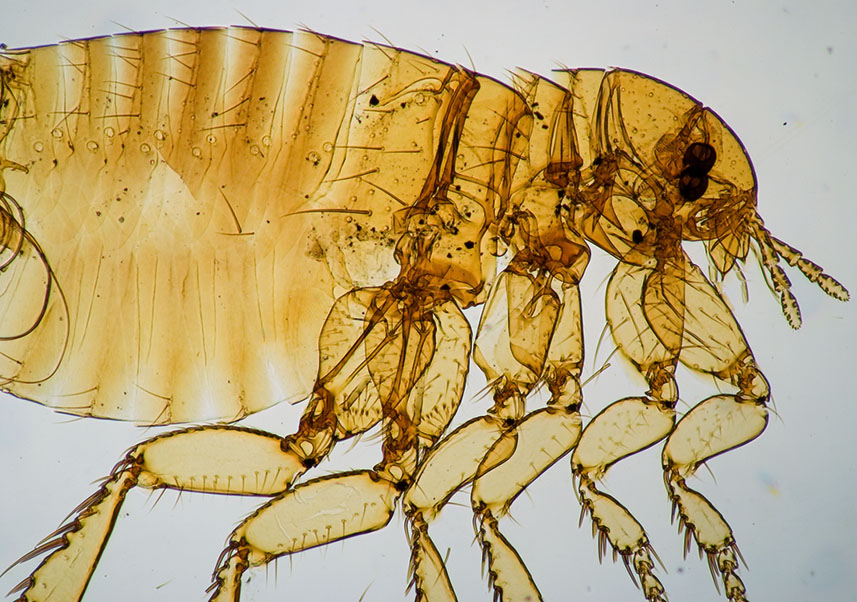
Human
flea, Pulex irritans, unnamed mounter, old slide, Zeiss 2.5x planachro NA0.08.
Tungsten 1/6th sec with exposure delay on. The Zeiss planachros worked well
with only a hint of chromatic aberration at edges when viewing images at
100% which would unlikely to be spotted in prints. Even with the Photomic's
excellent even lighting, the camera picks up minute lighting intensity changes
the eye doesn't see, especially at these lowest mags.
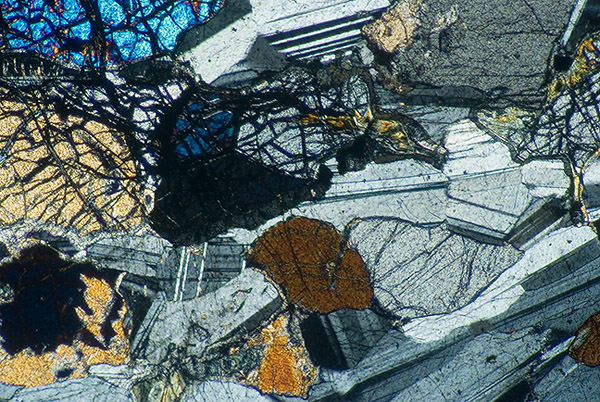
Gabbro
thin rock section, Open University slide K, set S260. Crossed polars with
lambda tint plate. Zeiss 2.5x planachro NA0.08. Tungsten 1/6th sec with
exposure delay on. Higher sharpening used as these slide sets have
a gritty surface lacquer rather than cover slip which spoils them for
imaging. The 10 Mpixel sensors squeeze smaller pixels into the same APS
sensor size, so noise can increase, but D80 seemed to give good blacks under
conditions tried.
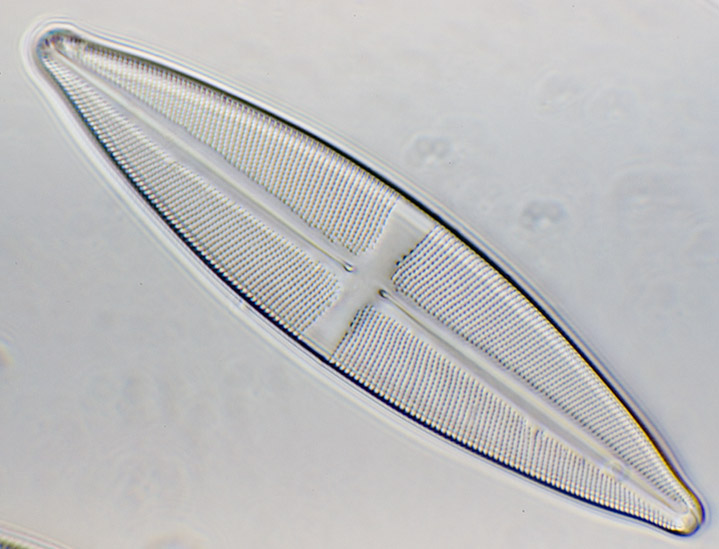
Nikon
D80: Diatom
Stauroneis phoenocenteron, Klaus Kemp 8 form test slide. Crop from frame.
Zeiss 40x NA1.0 planapo, slight oblique. Flash. As remarked in text, it's
at higher mags where there seems a surfeit of pixels to use a
DSLR for this sort of work unless a large print is desired. See examples
below to illustrate this.
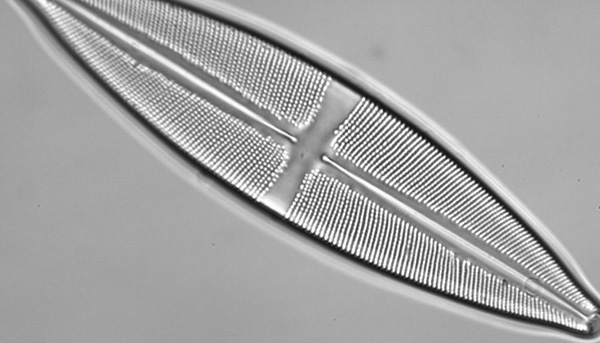
Above.
Same
subject and objective. Brightfield, no oblique. A 1.3 Mpixel webcam image resized
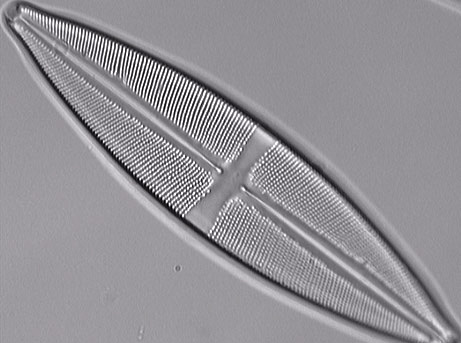
Above.
Same
subject and objective. Brightfield, no oblique. A domestic 0.3 Mpixel sensor
security camera;
video still resized.
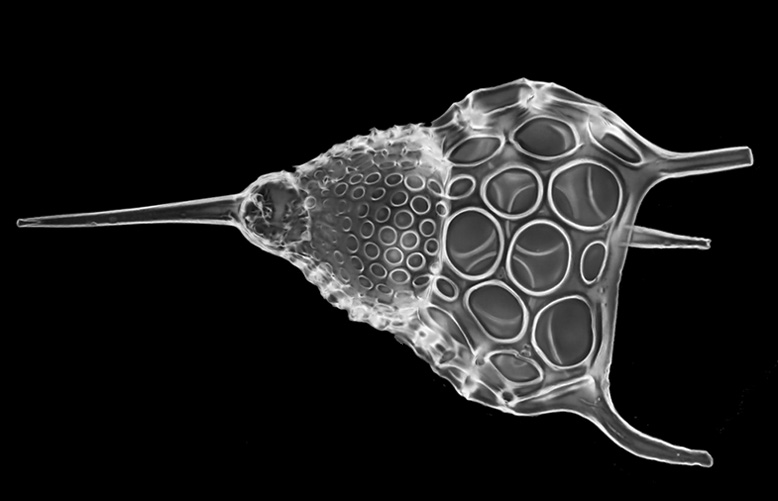
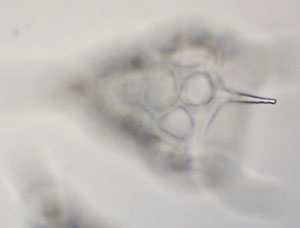
Radiolaria,
single specimen from arranged slide by Wim van Egmond. Zeiss Neofluar 16X
NA0.4. The rapid transfer of images with the Control Pro software and ability
to use 1/250th in brightfield with no vibration (with D80 'exposure delay'
on) allows image stacks to be created in a few minutes. 64 image stack in
brightfield and digital invert. Example of one focus plane shown right.
(I'm a beginner with Helicon Focus software so just used the default parameters.)
Comments
If
buying a DSLR for normal photography and the Nikon D80 is a contender, from
this limited look it certainly seems capable of competent results on a
microscope, with neither the lack of true mirror lock nor lens-off metering
a serious limitation. The 'exposure delay' feature of the D80
on the author's photomicro' setup gave me confidence to use objectives
at 10x and below with tungsten lighting at normal speeds e.g. 1/250th rather
than dropping to slow speeds to capture vibration free images. With a 40x
objective, 1/250th still gave vibration free images with 'exposure delay'.
The
'killer features' for my own preference of a 6 Mpixel DSLR (a D50) on a microscope
rather than a 3 Mpixel consumer digicam (a Sony S75) is not the extra megapixels
but the superior low noise performance, the powerful remote camera control
with quick image review and the
'big C' - Convenience! The DSLR can be securely and cheaply coupled to a
microscope albeit at the expense of the cropping factor
with my setup, whereas attaching my Sony S75 consumer digicam was a bodge at best with vignetting. Although
many suitable consumer digicams
like the Coolpix 9xx series, Sony W7 have been shown by users to work well on a microscope with
simple mechanical couplings and often without cropping problems.
My
own choice of a Nikon mount model was for the 35 mm film legacy but other DSLR makers offer features
on their models that Nikon haven't rapidly taken up on their budget to mid-priced models, notably true mirror
lock, lens-off metering, auto sensor dust removal, image stabilisation in camera
body and even live preview is
offered
by some makers now (e.g. Olympus E330, see Ted Clarke's article link below). If considering remote camera control and image transfer,
the software required and that for RAW image editing is worth factoring in as
it may be a considerable extra cost.
Do
you need 10 Mpixels for photomicroscopy? I find my 6.1 Mpixel Nikon D50 is excellent
for low to mid power microscopy but overkill
much of the time at higher mags and felt the D80 images on a
microscope were bigger but not necessarily better. The reason frequently cited for more megapixels is for
larger prints or perhaps the option to selectively crop, for which the
D80 is an excellent camera if budget permits. But these latest models are currently
a big commitment price wise and being the latest sensor have a correspondingly higher depreciation. For the microscopist keen to try a DSLR body, the older 3
- 6 Mpixel
models sell very competitively e.g. on eBay for a half to third of the price.
Comments to the
author
David
Walker
are welcomed.
Acknowledgement:
Thank you to a colleague for the extended loan of the Nikon
D80 over Christmas / New Year.
Footnote:
Initially I did not have full
D80 NEF file functionality in Photoshop Elements 3 with Adobe RAW 3.6 plug-in
until I discovered from
a web search that a plug-in left from running Nikon Capture will conflict if present
and should be moved, not just renamed;
see this resource).
Selection
of links:
Websites
reviewing digicams including DSLRs: DPreview, Imaging-Resource,
Megapixel.net, Steve's Digicams and Luminous
Landscape. The first two include rigorous tests of sensor parameters such
as resolution (with lens) and noise.
Micscape
articles on DSLR models for photomicroscopy.
Canon
350D on a Zeiss Axiostar assessed by Ian Walker.
Nikon
D50 on LOMO Biolam assessed by David Walker.
Nikon
D200 assessed by Dan McNeil.
External
articles on DSLR models for photomicroscopy.
'Adapting a Canon 300D (Digital Rebel) Camera for Photomicrography
Through a LOMO Multiscope Microscope' article
by Ken Vernon on www.amateurmicrography.net
(follow 'Articles' link).
'"How
to" tutorial series: About the use of digital single lens reflex cameras
on microscopes' by Jan Hinsch. Modern
Microscopy, February 2004. Includes suggestions for mounting a camera and
the use of SLR lenses for projection.
'Olympus
E330 DSLR for photomicrography with older design microscopes' by Ted Clarke,
Microscopy Today,
September 2006. Local
copy of article in pdf courtesy Ted Clarke and Microscopy Today
Editor. Ted Clarke article includes a description of the use of an Olympus
28 mm f2.8 lens for projection and also describes the benefits of the E330's
live preview with magnify mode. Detailed image of Figure 4 from this article
here, courtesy of Ted
Clarke. (Ted is currently assessing the E330 with a Meiji stereo on a homemade
stand, personal communication, see this image
of set-up kindly supplied Ted.)
The
multi-award winning photomicrographer Charles Krebs shares his set-up and techniques
on his website.
The
microscopy forums listed on the Micscape Index
are an excellent place to read enthusiasts' experiences with various DSLR models
as well as discussions on the pros and cons of DSLRs cf consumer digicams for
photomicroscopy.
Nikon
MicroscopyU website interactive tutorials.
'CCD
resolution for optical microscopy'
'Digital
camera resolution requirements for optical microscopy'
'Spatial
resolution'
(Note
that the sensor type in consumer rather than scientific digicams can be another
parameter to consider e.g. whether Bayer or Foveon, see this DPreview
resource.)
© Microscopy UK or their contributors.
Published in the January 2007 edition of
Micscape.
Please report any Web problems or offer general comments to
the
Micscape
Editor
.
Micscape is the on-line monthly magazine of the Microscopy
UK web site at
Microscopy-UK
© Onview.net Ltd, Microscopy-UK, and all contributors 1995
onwards. All rights reserved.
Main site is
at www.microscopy-uk.org.uk
with full mirror
at www.microscopy-uk.net
.
 The
D80 was attached via a third party 35 mm photomicro' adaptor to a vertical
monocular tube on the spare top port of a Zeiss Photomicroscope III (shown right). A
USB 2.0 cable enables remote control and image transfer to a PC. A Wein SafeSync
adaptor was used for flash work with an old SunPak
2400 flash gun when required (sat on field lens below condenser).
The
D80 was attached via a third party 35 mm photomicro' adaptor to a vertical
monocular tube on the spare top port of a Zeiss Photomicroscope III (shown right). A
USB 2.0 cable enables remote control and image transfer to a PC. A Wein SafeSync
adaptor was used for flash work with an old SunPak
2400 flash gun when required (sat on field lens below condenser). 